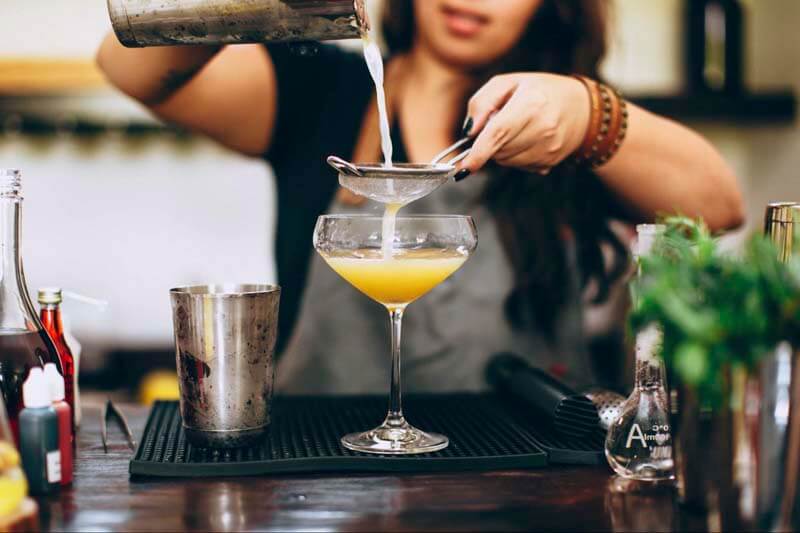
There is nothing better than a full bar. As a bar owner, witnessing patrons sipping cocktails and engaging in conversation is a sign of repeat business and a profitable day.
According to a National Restaurant Association study, the typical bartender can make thirty-six drinks in an hour. To get the most out of your liquor bottles and maximize your margins on a busy night, it’s critical that your bartenders are well-versed in standard liquor pours.
We’re here to make sure your staff understands the standard liquor pouring techniques so they can consistently make the best-tasting cocktails for your customers.
What We’ll Cover in This Piece:
What Is a Standard Liquor Pour?

Photo by Louis Hansel on Unsplash
The National Institute of Health’s guidelines states that a standard liquor pour at most bars across the U.S. is 1.5 ounces.
It’s crucial to maintain a consistent liquor pour since, in addition to preventing you from overserving customers, it’s the ideal quantity for creating a well-balanced drink.
Plus, an accurate pour means that you’re not over-using your liquor supply and are keeping your margins in check.
There are three ways to identify a standard pour: as a shot, neat, or in a cocktail.
1. Shot
This can refer to a 1.5-ounce pour of plain liquor or a mixed shot.
Shots are typically served in a shot glass.
2. Neat
A shot pour and a neat pour are separated by half an ounce. A tumbler, snifter, or low-ball glass is used to serve 2-ounce standard neat pours.
Those who prefer a neat pour frequently order a higher-quality spirit and sip it slowly, as opposed to a normal poured shot of booze, which is supposed to be rapidly poured and drunk.
Since you are getting more alcohol, neat portions usually cost a little more, but the glassware makes the biggest difference.
3. In a Cocktail
The quantity of liquor will change depending on the cocktail you’re mixing. For instance, a Long Island Iced Tea requires more than six ounces of alcohol, yet an Old Fashioned only needs roughly two ounces of rye or whiskey.
This is the time for your bartender to choose their favorite measuring tools to ensure they create flawlessly balanced cocktails each and every time.
The 2 Best Tools to Ensure a Standard Pour
There are two tools that you can invest in to help ensure your bartenders are serving the accurate amount of tequila in margaritas and vodka in your martinis, for example.
A Jigger Tool
A jigger is a common bar accessory that serves as a measuring cup for mixed drinks. A jigger can be used to precisely measure the volume of liquid that is actually being poured. It enables bartenders to maintain consistency with correct measurements while lowering over-pouring situations.
Weighing between 0.5 and 2.5 ounces, jiggers have two sides with different capacities on either end. Which is one of their main advantages, because it allows bartenders to quickly mix drinks of varying sizes with just one tool.

Photo by Aurélien Lemasson-Théobald on Unsplash
A Pour Spout
A bartender may pour more accurately and quickly with the help of a pour spout. These cone-shaped caps that protrude from liquor bottles save a bartender time behind the bar because they don’t need to constantly unscrew lids.
There are different varieties of pour spouts. Some are standard bottle toppers that are metal or plastic, and some are even digital!
The digital ones have the capability to connect to your POS system wirelessly in order to offer a real-time analysis of your liquor supply.
Each time the bottle is tipped upside down, the pour spout discharges a specific volume of liquid (usually the typical 1.5- or 2-ounce shot).
Many seasoned bartenders use this tool instead of a jigger because it allows them to prepare a lot more cocktails in a short amount of time while still being extremely accurate.
Why Standard Liquor Pours Keep Your Business Profitable

Photo by Ivan Cortez on Unsplash
Did you know that there are only sixteen 1.5-fl-oz shots available in a typical 750mL bottle of gin? If your bartenders are over-pouring, you can imagine how rapidly a bottle may be kicked given that a typical martini calls for two shots of gin.
Overpouring has a negative impact on a bar’s menu and revenue. Calculating your pour cost can help you retain profits by enabling you to compare the cost of a drink’s ingredients to its selling price at the drink level.
So how do you calculate the pour cost for a cocktail?
Your pour cost is calculated by dividing the amount of inventory you’re utilizing, expressed in dollars, by the amount you’re selling. A bar’s typical pour costs range from eighteen percent to twenty-four percent, but the majority of bar owners think twenty percent is a good target.
Pro Tip: Pour costs are proven more effective when reviewed weekly because it enables managers to spot trends and handle problems before they arise.
Make sure your bartender has easy-to-access reference sheets for liquor pour sizes so they can consistently make precisely proportioned cocktails.
By using the right measuring tools, understanding the cost of a standard liquor pour, and setting clear expectations with your bartenders, you can ensure that you make flawlessly balanced beverages every time while maximizing your chances to increase your profits.
Other Content You May Enjoy
To succeed and grow your restaurant, bar, or brewery you need to stand out in local search results. Whether someone is searching for the “best craft beer near me” or “top-rated seafood restaurant in [your city],” Local SEO (Search Engine Optimization) helps your business appear at the top of those search results.
With 81% of consumers using Google Search and Maps to find local businesses, and nearly 90% of customers choosing a business on the first page of search results, optimizing your online presence is essential.
This guide will walk you through Local SEO strategies tailored for restaurants, bars, and breweries, covering Google My Business, website optimization, online reviews, local backlinks, and more.
By the end of this guide, you’ll have a step-by-step action plan to increase your search rankings, attract more local customers, and grow your business.
In today’s digital world, having a well-designed, functional website is essential for restaurants, bars, and breweries. It goes beyond having social media. A great website can help attract new customers, showcase menus, accept reservations, and even drive online sales. But one of the most common questions business owners ask is: How much should a website cost in 2025?
The answer depends on several factors, including the type of website, features, complexity, and whether you choose a DIY solution or hire a professional web developer. Costs can range from a few hundred dollars for a basic website to tens of thousands for a fully customized, feature-rich platform.
This guide will break down website costs for restaurants, bars, and breweries, helping you understand the pricing landscape and choose the best solution for your business
Trivia nights have become an incredible marketing strategy for bars, restaurants, and breweries to draw in crowds and engage with new customers. With the recent collaboration between Geeks Who Drink, Timeplay, and the iconic television show Jeopardy!, businesses now have an exciting opportunity to host the Jeopardy! Bar League. This partnership combines the global brand recognition of Jeopardy! with Timeplay’s cutting-edge technology and the fun of live trivia from the experts at Geeks Who Drink.
In this piece we’ll cover what this new collaboration between these two trivia powerhouses is and how you can bring this unique experience to your venue.
In today’s world, both websites and social media platforms are crucial for a brewery, bar, or restaurant’s online presence. However, consumer habits show distinct preferences for each, depending on the context of their search or interaction.
In this guide, we’ll go over the basics, walk you through how to leverage these tools effectively, and show you how understanding these trends can help your venue better meet your customers’ expectations.
As a restaurant, bar, brewery, or any venue with a food and beverage program, having a modern, functional, and aesthetically pleasing website isn’t just a luxury—it’s a necessity.
No matter the size of your business, your new potential customers often interact with your website first—and first impressions matter.
In this piece, we’ll explore the top website trends shaping the online presence of hospitality businesses in 2025. These trends will help your venue stand out and attract more customers while creating a unique and modern experience to establish the perfect guest experience from start to finish.
For bar owners, hospitality managers, and small business owners, selecting the right gin brands is more than just filling the shelves—it’s about curating a distinctive customer experience. Gin has soared in popularity, becoming a staple of modern cocktail culture. With its complex botanical infusions, gin offers versatile, memorable flavors that can attract a wide range of customers. But with so many choices available, which brands should you prioritize to bring out the best in your gin menu?
This guide explores the seven best gin brands that have proven themselves through quality, craftsmanship, and unique flavor profiles. By understanding what makes each brand special, you and your staff will be better equipped to create a standout gin selection that delights your patrons, reinforces your brand’s reputation with a robust gin drinks menu, and helps you continue crafting classic and innovative gin cocktails.

